The scrum methodology was developed as a response to rigid project management approaches such as the waterfall method, which didn’t adapt to the needs of agile product and software development teams. We’ll explore the scrum methodology in-depth, but before that, let’s start with a simple scrum definition.
What Is Scrum?
Scrum is a project management framework that facilitates team collaboration on complex product and software development projects. The good news is that scrum is easy to understand. The bad news? It’s hard to master.
What Is the Scrum Methodology?
The scrum methodology emphasizes teamwork in project management. It stresses accountability and iterative progress toward a well-defined goal. Scrum is part of agile software development and teams practice agile. The name comes from the sport of rugby, where scrum is a formation where everyone plays a specific role, but everyone is working towards a quick adoption of strategies.
The necessary collaboration required for a successful scrum is facilitated by ProjectManager, online and project management software that connects scrum teams wherever they work. Collaborative to the core, our platform delivers real-time data that allow scrum teams to comment on tasks during a sprint, share files and much more. Get started today for free.
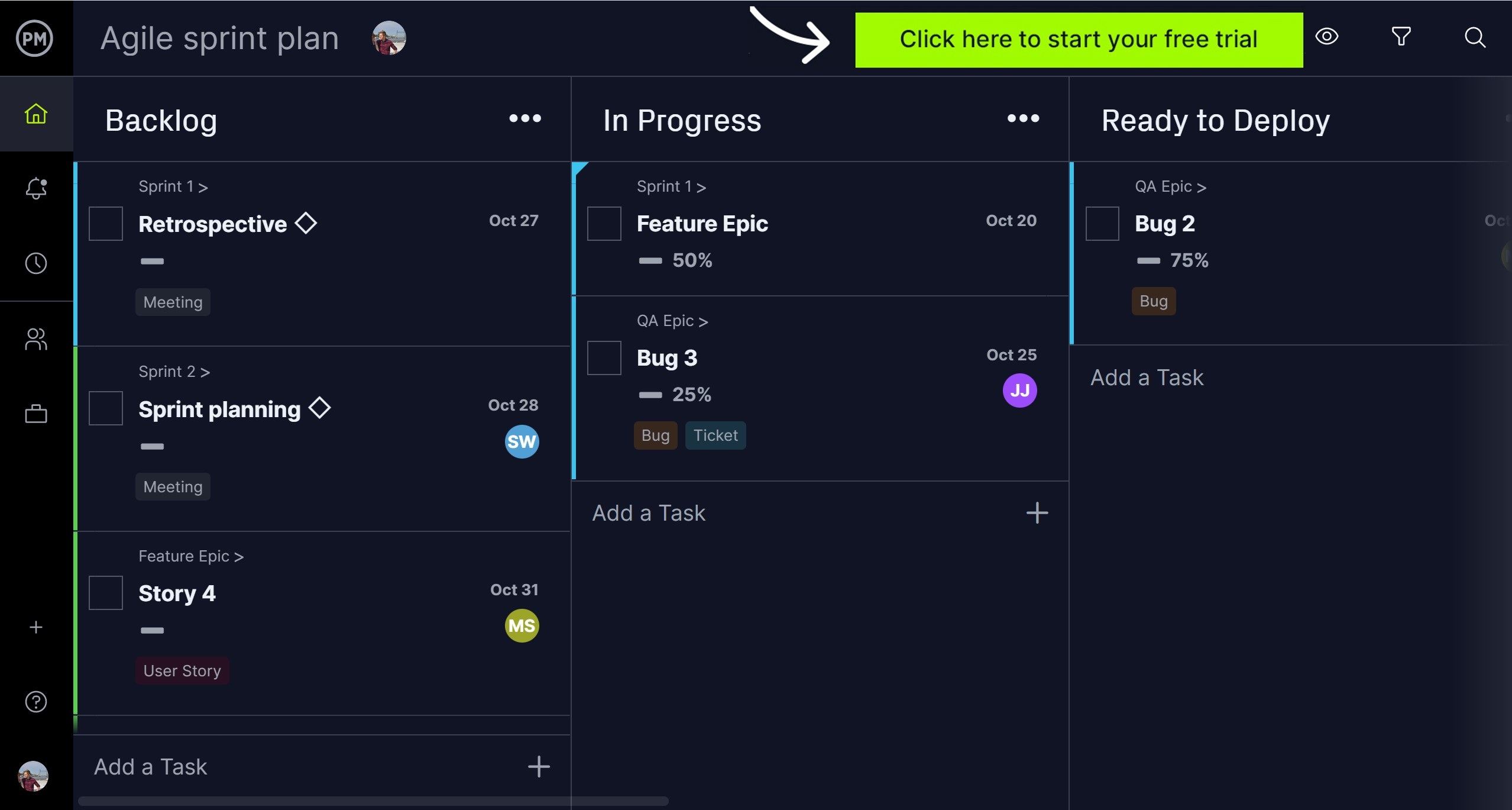
Scrum vs. Agile
Scrum is a part of the agile process, but certainly not the only part. Agile is a large tent, but scrum is an important pillar. Think of scrum as a framework by which you can implement agile development. Agile doesn’t have a set of steps to follow, so scrum provides a means to apply agile to your project. There are many frameworks that you can use in agile development, such as extreme programming or feature-driven development, but scrum’s simplicity and autonomy are selling points.
The scrum methodology can also be used as an entry point to other agile practices. It’s also not solely a framework for software but can benefit many other kinds of projects.
When Should You Use the Scrum Methodology?
Any team that’s working to produce an end product can use scrum methodology, whether it be a software program, marketing campaign, website or even a new product or building. In reality, it can be applied to any project in any industry. A good rule of thumb is to use the scrum methodology if your project requires that you figure out how to do a significant amount of the work. If you’ve executed many similar projects before and you know how to approach the project again, you can opt for a waterfall approach.
Scrum in Software Development
Scrum is commonly used in software development as developers execute the work that’s required to complete each sprint. The framework was formalized for software development projects. Scrum allows for constant feedback and flexibility and software developers can focus on developing one or more features within a particular time frame referred to as a sprint which is usually one month or less. When the product is finished, it’s ready to be released.
Scrum in Product Development
Product development teams use scrum similarly to software development teams. When product development teams employ the scrum methodology, they break down long-term plans into sprints. During this time, they’ll work on only select projects to make frequent product updates that hit the marketplace as quickly and efficiently as possible.
Scrum in Project Management
The scrum process is led by the scrum master who aims to remove obstacles to the work getting done. Scrum teams meet daily to talk about roadblocks that could sidetrack projects. It’s ideal for managing projects that require fast development and testing, especially amongst a small team.
What Are the Artifacts of the Scrum Methodology?
In the scrum methodology, the term artifact refers to key concepts that are used by the scrum team to develop products in an agile environment. We’ll go through the most critical artifacts that every scrum team needs: product backlog, sprint backlog and product increment.
- Product backlog: The product owner makes a list of work that needs to be done, and they’ll place it in order according to priority. This is building your project backlog. They do this by determining what is a must-have item, which is less critical and those that don’t fit into the timeframe allotted. That means the value of each item must be clear. What is their impact and risk and how the item might help in the learning process?
- Sprint backlog: The sprint backlog can be simply defined as the set of user stories in which the scrum team will be working in a single sprint. It’s important to make sure that the most critical user stories are always the ones that are being worked on and none of them fall through the cracks.
- Product increment: The term product increment refers to all the product backlog items that have been completed during a sprint. It can also be used to describe the sum of all the completed backlog items and user stories.
The scrum methodology theory has evolved with time. Scrum experts have suggested that there are actually 7 scrum artifacts. This expanded vision can be very helpful to further define the scrum team’s objectives.
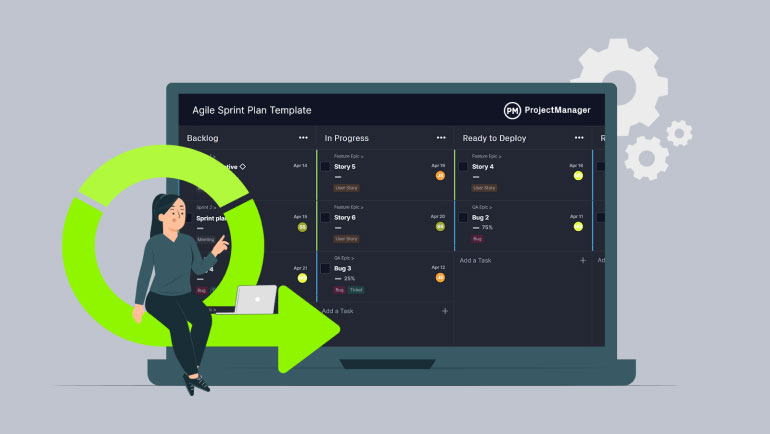
Get your free
Agile sprint plan template
Use this free Agile sprint plan template to manage your projects better.
Open in ProjectManager
What Are the Scrum Events in the Scrum Process?
These scrum events or scrum ceremonies foster team collaboration and ensure that there’s a constant line of communication among the scrum team members through the product or software development life cycle.
- Sprint Planning: Using the product backlog, teams start with the highest priority items and determine how to achieve this objective. A good tip when sprint planning is to do the due diligence and only start with ready items. Also, remember that planning is a short process, so don’t get bogged down in the details. Simply get to work on meeting the objectives and keep the plan collaborative. The team should also ask the product owner and stakeholder questions.
- Daily Scrum Meeting: These are 15-minute meetings where everybody in the scrum team talks about the tasks they’ll be working on during the day and share any roadblocks or difficulties they’re facing. There’s no need to make this daily scrum meeting longer, as there are other meetings such as sprint reviews and sprint retrospectives to explore more complex topics.
- Sprint Review: You want to look back on the sprint and see what worked and what didn’t. You can then take the information and apply it to future sprints to replicate the positives and reduce the negatives. Begin the sprint review process by thanking participants, offering short introductions and setting ground rules for the discussion.
- Sprint Retrospective: The sprint retrospective meeting gives the scrum team a space to reflect on the last sprint and determine what went well and wrong. Stakeholder and customer feedback are also gathered to prioritize user stories and improve product performance.
- Backlog Grooming: Once through this cycle, it starts over again by going back to the backlog and taking the next ready item at the top of the priority list. Backlog grooming consists of improving the scrum process through the prioritization of work based on prior experience and continuing to refine the work to make it as efficient as possible.
What Are the Main Roles In a Scrum Team?
As with anything in project management, the scrum methodology needs people to be executed. For this purpose, it defines three scrum roles, a scrum master, a product owner and a development team that’s made up of several team members.
- Scrum Master: The scrum master, as his name suggests, is a scrum methodology expert. He guarantees that everybody in the scrum team understands how the framework works and helps them adapt to the agile environment. He leads scrum meetings.
- Scrum Product Owner: The scrum product owner manages the product log and oversees sprint planning and actively participates in scrum meetings. In a sense, they act as a project manager because they lead backlog grooming and prioritize user stories to help the teamwork better.
- Scrum Development Team: The scrum development team is simply made up of all the team members who develop software or products. They must work closely with the product owner and adhere to the scrum master’s suggestions.
What Are Scrum Values in the Scrum Methodology?
Scrum values are the guiding principles of the scrum methodology. They’re simple statements that work as agile best practices. The agile values come from the Agile Manifesto, a document with the guiding principles of the agile project management methodology. Let’s quickly explain what they’re about.
- Individuals and interactions over processes and tools: Processes and tools are important in software development, but individuals and how they interact with those processes and tools are more important.
- Working software over comprehensive documentation: Before the Agile Manifesto, software developers focused heavily on documentation. This value states that while documentation is important, focusing on developing the software should be the primary goal of the scrum team.
- Customer collaboration over contract negotiation: This value explains that collaborating with customers to create a high-quality product is much more important than drafting a rigid contract that limits product development, as it used to be done in the old software development days.
- Responding to change over following a plan: This value states that agile is a project management methodology that seamlessly adapts to change based on an iterative product development cycle and not a rigid project plan.
Advantages of the Scrum Methodology
There are many unique advantages that scrum offers that can entice you if you’re considering using scrum for your team.
- Flexibility: If your project undergoes frequent changes, scrum provides adaptability that other methods don’t. It’s easy to pivot without losing the hard work you’ve already completed.
- Visibility: Stakeholders feel more involved as they’re able to see progress incrementally instead of solely during outlined check-in points in the project.
- Efficiency: The goal is to deliver work as efficiently as possible, a goal that’s often achieved within scrum’s short sprints.
Disadvantages of the Scrum Methodology
There are challenges with any project management methodology and scrum is no exception.
- Scope creep: The lack of a definitive project end date can result in using more resources than you originally anticipated.
- Requires a small, committed team: It’s challenging to achieve success with scrum if you have a large team or if team members aren’t committed to project success.
- Not ideal for all projects: If you have a fixed project scope and timeline that cannot move, it likely isn’t suitable for scrum.
History of the Scrum Methodology
The scrum process has its origins in the early 1990s. Jeff Sutherland and Ken Schwaber came up with the process, which they presented to the Object-Oriented Programming, Systems, Languages & Applications (OOPSLA) conference in Austin, Texas in 1995. They formalized the methodology in a published paper called “SCRUM Software Development Process.”
The name scrum, however, was inherited from a paper published in 1986 by management experts Hirotaka Takeuchi and Ikujiro Nonaka, called “The New New Product Development Game.” They were using the word scrum as it related to rugby as a means of stressing the importance of team collaboration for project success. By 2001, Sutherland and Schwaber and 15 other software development leaders created the Manifesto for Agile Software Development. Shortly afterward, the Agile Alliance was founded. Schwaber co-authored with Mike Beedle, the first book on scrum, Agile Software Development with Scrum, in 2001.
The Scrum Alliance was founded in 2002 by Schwaber, a chairman, with Mike Cohn and Esther Derbry. They later added a certification arm to the organization, with Certified ScrumMaster programs.
Glossary of Scrum Methodology Terms
Before defining the framework of scrum, here’s a short list of some of the more common terms used when working within a scrum environment.
- Burndown chart: A burndown chart shows much effort is left compared to time
- Burnup chart: Measures the increase in a measure against time
- Definition of done: The definition of done (DOD) is one of the seven scrum artifacts. It’s an acceptance criterion agreed upon by the scrum team
- Product backlog: A product backlog is work to be done in a specific order
- Product backlog refinement: When the product owner and team add detail to the product backlog, also known as backlog grooming
- Scrum board: A scrum board helps scrum teams manage their work
- Scrumban: Scrumban is a hybrid methodology that combines scrum and kanban project management
- Sprint: Short tasks, one following immediately after the completion of another
- Sprint backlog: What the team needs to complete the sprint
- Sprint goal: The purpose of the sprint
- Sprint planning: Sprint planning is a spring event where scrum teams plan their upcoming sprint
- Sprint retrospective: Short post-mortem of the sprint
- Sprint review: Short review of the sprint to help add improvements to the next one
How ProjectManager Enables the Scrum Process
Scrum methodology requires collaboration and flexibility. ProjectManager, online work and project management software connects scrum teams and gives them the tools they need to work in an agile environment. Our tool delivers real-time data that keeps everyone updated and communicating no matter where they are, how they work or what role they have in the project.
Create and Manage Scrum Boards
Our multiple project views mean that other departments can collaborate on Gantt charts or our sheet view. But scrum teams will use our scrum board view, which allows them to manage their backlog of user stories and work together when planning a sprint.
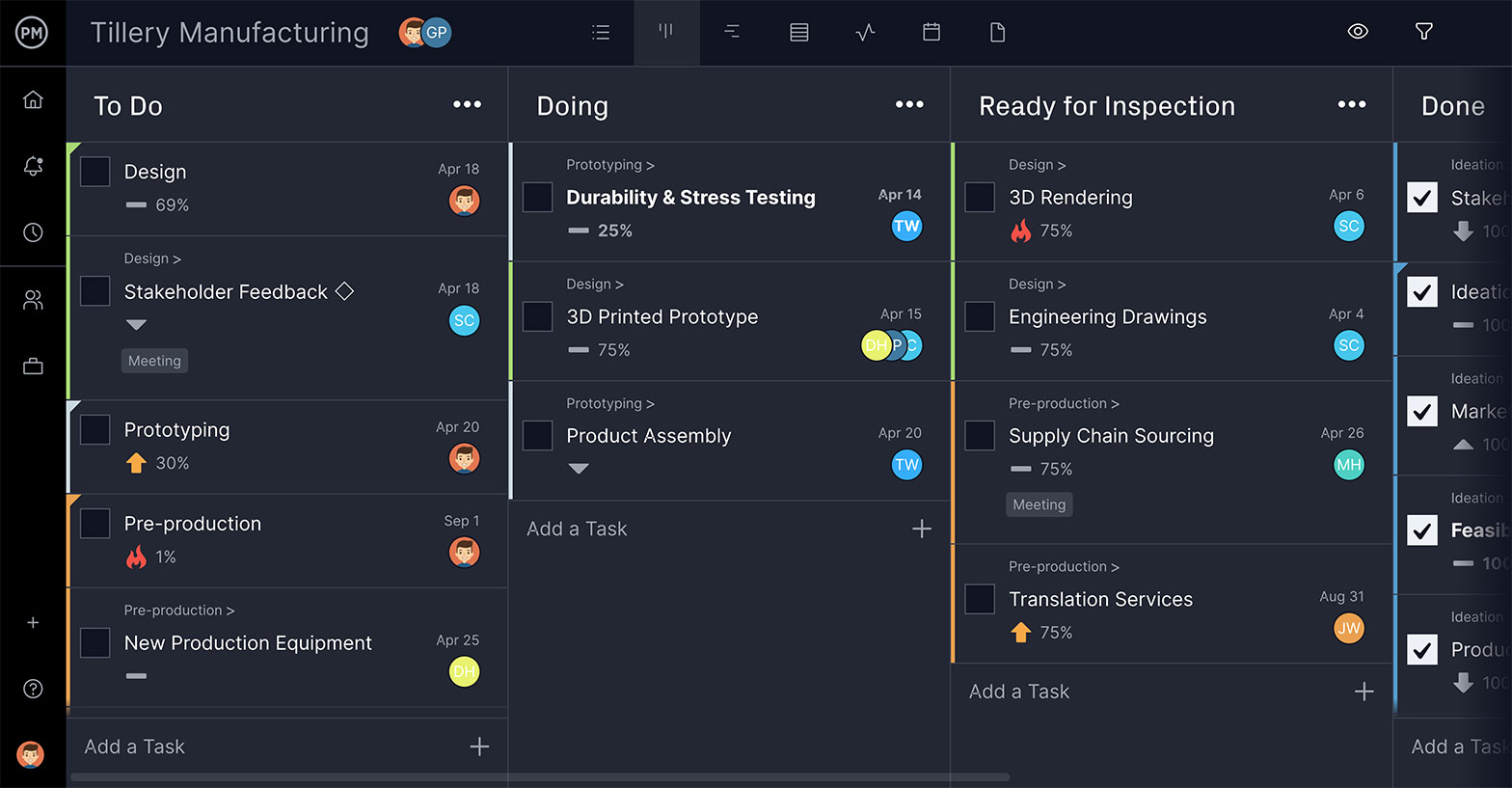
Scrum boards also give product owners and scrum masters the visibility to track progress and catch potential bottlenecks, which can be quickly cleared by reallocating resources.
Track Scrum Workflows With Real-Time Dashboards
You don’t want to get in the way of your self-directed team, but you need to know what they’re doing. Our real-time dashboard tracks six project metrics. There’s no setup required as with inferior products. Our custom workflows allow you to apply triggers that set actions automatically to free your team to focus on their work. Plus, task approvals give you control of status changes.
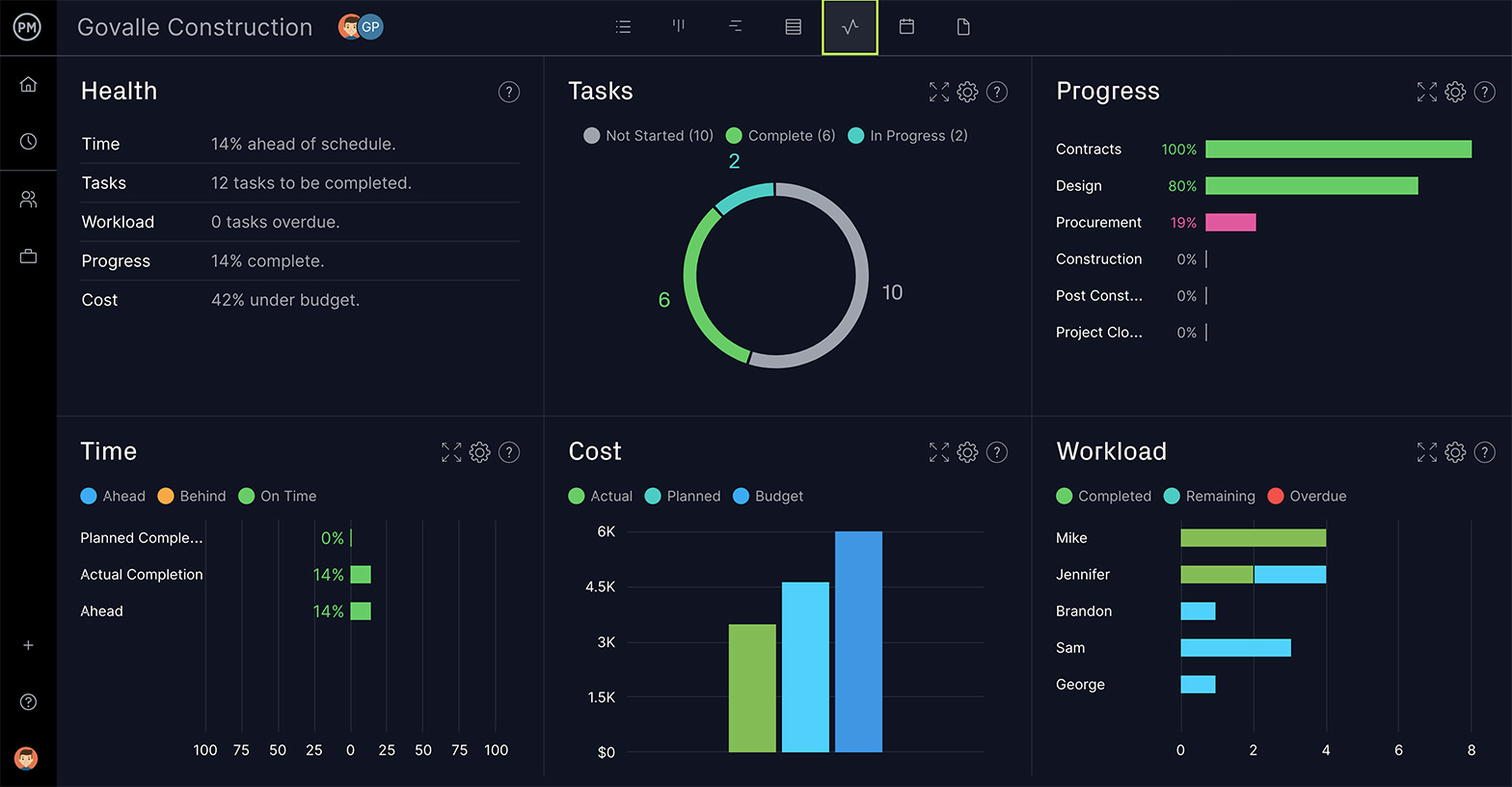
Collaborate With Your Scrum Team
Whether your team is under one roof or working across time zones, our online tool allows them to work together. Team members can comment at the task level, tag others not assigned to that task to bring them into the conversation and share images and documents. Email notifications and in-app alerts keep everyone up-to-date instantly.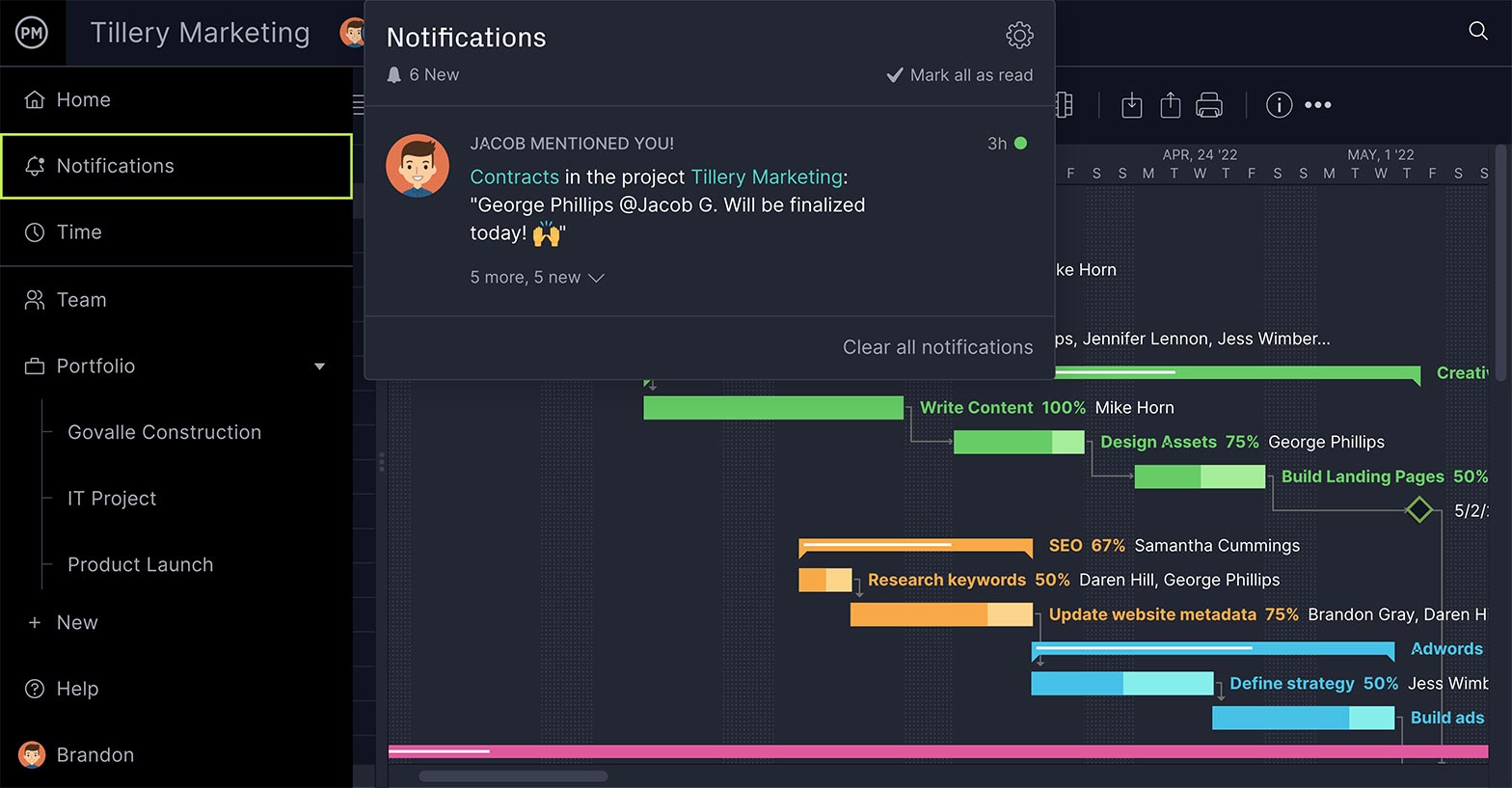
Not only is our software ideal for scrum, but it can also work with more traditional methodologies like waterfall or a hybrid of many project management methods. Our tool allows you to collaborate with other departments in your organization that aren’t agile. It’s the only work and project management tool you’ll need to deliver success.
ProjectManager is project management software that’s uniquely positioned to help project managers through every phase of their work, regardless of the methodology. Being cloud-based, it collects real-time data and has the tools to help teams collaborate, giving them the autonomy required of scrum with the monitoring and management to keep on schedule and within budget. See how it can help you and your team by taking this free 30-day trial.

